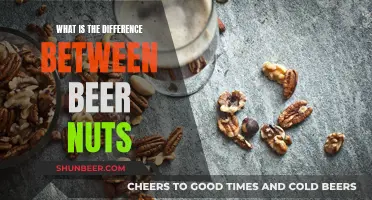
Hazy IPAs, also known as New England IPAs (NEIPAs), are a variation on the traditional India Pale Ale (IPA) beer style. The difference between a hazy IPA and a standard American-style IPA is immediately apparent visually—the former is cloudy and opaque, while the latter is clear. Hazy IPAs are less bitter than standard IPAs and are known for their juicy, fruity flavours and creamy mouthfeel. They are also unfiltered, which contributes to their haze and cloudiness.
| Characteristics | Values |
|---|---|
| Appearance | Cloudy, hazy, opaque, not clear |
| Flavour | Juicy, fruity, tropical, citrus, full-bodied, bitter |
| Mouthfeel | Soft, Smooth, Creamy, Thick, Satisfying |
| Alcohol Content | Varied, from session beers to Imperial beers |
| Bitterness | Lower than other IPAs |
| Calories | Varied, e.g. 143-214 calories per 12-ounce can |
| Haze Composition | Grain protein, Polyphenols, Starch, Fruit pectins |
| Brewing Method | Unfiltered, Dry-hopping, Late hopping, Whirlpooling |
| Hops | Added during fermentation, lower temperatures |
| Yeast | Remains suspended, low flocculation |
What You'll Learn

Hazy IPAs are unfiltered
The haze or cloudiness of the beer is called turbidity, and it is controlled by three main ingredients: hops, yeast, and grains. Hazy beers use a specific yeast strain that promotes suspension in the beer and reduces flocculation, which is the tendency to clump or form a larger mass. By using a low flocculating yeast, the yeast is more likely to stay in the beer and contribute to its cloudy appearance.
Additionally, including high-protein grains such as oats, spelt, or wheat also leads to cloudiness and a softer, smoother body. This protein, in combination with hops, is crucial in creating haziness. When brewing a Hazy IPA, little to no hops are added to the boil. Instead, the hops are used in a process known as dry-hopping, which does not pull the bitterness from the hops like boiling does but instead enhances the brightness of flavour and bursts of aroma.
The haze associated with Hazy IPAs is typically attributed to the hops, and the polyphenols from the hops remain in the beer and bind with the proteins from the grains, creating the hazy appearance. This is called colloidal haze, and it is this haze that translates to the turbidity of the beer.
Hazy IPAs are not the only beers that are unfiltered. Other styles of beer that are unfiltered include Kellerbier, Witbiers, Berliner Weisses, and other sour offerings.
Mexican Beers: Unique Flavors and a Cultural Legacy
You may want to see also

Haze comes from grain protein
Hazy IPAs, also known as New England-style IPAs or NEIPAs, are characterised by their cloudy, opaque appearance. This is caused by a combination of factors, including the use of unfiltered wheat and barley grains, high levels of proteins, and polyphenols.
The haze in these beers comes primarily from grain protein. Wheat has a much higher protein content than barley, the base ingredient in most beers. When proteins from these grains interact with polyphenols—plant-derived flavonoid compounds like tannins—they create a colloidal haze. This haze is made up of large, insoluble organic compounds that remain suspended in the beer, giving it a cloudy appearance.
Brewers can also add oats, which contribute starch to the haze, as well as hops that are high in tropical and fruity aroma compounds. These ingredients work together to create a stable haze that persists throughout the life of the beer.
The key to achieving a consistent and attractive haze in hazy IPAs is striking a delicate balance between the right ingredients and brewing processes. While filtration can be used to clarify beer, hazy IPAs skip this step to retain the haze and the additional flavour and mouthfeel it provides.
Salt Life Beverage LLC: Exploring Their Beer Variety
You may want to see also

Fruity, tropical flavours
When it comes to IPA beers, one of the most popular and distinctive styles is the hazy or cloudy IPA, known for its juicy, fruity, and tropical flavours. These beers are often packed with vibrant, fruit-forward aromas and flavours that tantalize the taste buds and offer a unique drinking experience. The use of certain hops and yeast strains is key to achieving these characteristic flavours in hazy IPAs, and they have become a favourite among craft beer enthusiasts and brewers alike.
The fruity, tropical notes in hazy IPAs are often the result of specific hop varieties used during the brewing process. Hops like Citra, Mosaic, Galaxy, and Simcoe are commonly employed to impart vibrant flavours of mango, passionfruit, pineapple, and stone fruits. These hops are known for their high oil content and strong aromatic qualities, contributing to the intense and juicy character of the beer. Brewers often use late hop additions or dry-hopping techniques to maximize these fruity, tropical aromas and flavours without adding excessive bitterness.
Certain yeast strains, such as the popular London Fog yeast, also play a crucial role in developing these desirable fruity attributes. These yeasts are chosen for their ability to accentuate ester production, which contributes to the perception of fruity notes in the beer. The yeast strains may also contribute subtle underlying flavours, such as a hint of peach or apricot, adding complexity to the overall tropical fruit character of the hazy IPA.
Additionally, brewers may experiment with different grain bills to complement and enhance the fruity, tropical flavours in their hazy IPAs. For example, the use of oats and wheat can provide a smooth, creamy mouthfeel that accentuates the juiciness of the fruit flavours. A careful balance of maltiness is also essential to providing a solid backbone for the hops, ensuring the beer isn't overly sweet but still has enough body and depth to support the bold, fruity character.
Domestic vs Draft Beer: What's the Real Difference?
You may want to see also

Less bitter than other IPAs
Hazy IPAs, also known as New England IPAs, are less bitter than other IPAs. This is due to a few factors, including the type of yeast and malt used, as well as the timing of the addition of hops during the brewing process.
When making a hazy IPA, brewers use low to moderately flocculating yeast strains, which result in cloudier beers with a more opaque appearance. In terms of malt, they often use malts with higher protein levels, such as oat or wheat, and may also add lactose, resulting in a hazy appearance and a smoother, creamier mouthfeel.
The timing of the addition of hops also plays a crucial role in reducing bitterness. In a regular IPA, hops are added early in the brewing process, leading to stronger bitterness and hop flavour. However, in a hazy IPA, brewers utilise a technique called "dry-hopping", where hops are added later in the production process, after the initial fermentation. This results in beers with significantly lower bitterness but strong fruity aromas and flavours.
The combination of these factors results in hazy IPAs having a lower bitterness level compared to other IPAs. This has contributed to their popularity, especially among craft beer drinkers who prefer less bitter brews. The fruity and juicy characteristics of hazy IPAs, along with their creamy mouthfeel, make them a refreshing choice, particularly during warm weather.
It is worth noting that the perception of bitterness can be influenced by various factors, including a beer's alcohol content, malt profile, and residual sugars. While International Bitterness Units (IBUs) are used to measure bitterness in beer, they may not always reflect the actual bitterness perceived by drinkers. Therefore, while hazy IPAs tend to have lower bitterness levels, the overall flavour profile and balance of the beer also contribute to the drinking experience.
Beer's Reaction to Containers: A Study
You may want to see also

Also known as New England IPAs
Hazy IPAs, also known as New England IPAs (NEIPAs), are believed to have originated in the New England region of the US in the 2010s. The "Heady Topper", created by John Kimmich at the Vermont brewery, The Alchemist, in 2003, is recognised as the original hazy IPA.
Hazy IPAs are heavily hopped with New World hop varieties like Citra, Mosaic or Sabro, which are often added later in the brewing process at lower temperatures. The hops can be added during a stage known as 'whirlpooling', or after fermentation, which is known as 'dry hopping'. The use of these hops results in the fruity, tropical flavours and aromas that Hazy IPAs are known for.
Hazy IPAs are also characterised by their cloudy, opaque appearance, which is caused by the higher protein content of grains such as oats and wheat used in the brewing process. This natural haze is further developed by adding hops during the peak of fermentation, which starts a process of biotransformation, providing even more haze and unlocking aromatic compounds from the hops.
The mouthfeel of a Hazy IPA tends to be soft, smooth and creamy, with lower perceived bitterness than other IPAs. The combination of haze, mouthfeel and juicy, fruity flavours has made Hazy IPAs a popular style of craft beer.
What's the Real Difference in Draft Beer?
You may want to see also
Frequently asked questions
A Hazy IPA, also known as a New England IPA (NEIPA), is a variation on the traditional India Pale Ale (IPA). It is characterised by its cloudy, opaque appearance, and tropical aroma. Hazy IPAs are less bitter than standard IPAs, and are known for their fruity flavours and smooth mouthfeel.
Hazy IPAs are cloudy due to the inclusion of grains with higher protein content, such as oats and wheat, which create a natural haze during the brewing process.
Virtually all NEIPAs are Hazy IPAs, but not all Hazy IPAs are NEIPAs. The distinction is largely one of regional recognition, with "Hazy IPA" being used more commonly in the Northeast region of the US, and "NEIPA" being used in other parts of the country. NEIPAs also tend to be thicker in mouthfeel and texture, cloudier in appearance, and more aromatic than Hazy IPAs.







